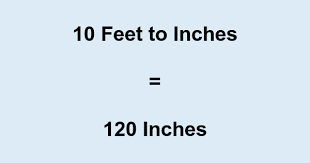When it comes to measurements, one question that pops up often is, “How Many Inches Is 10 Feet?” Whether you’re diving into construction plans, tackling a DIY project, or just indulging in curiosity, knowing how to convert feet to inches is essential. But wait! It’s not just about crunching numbers; it’s about understanding why such conversions matter in everyday life—and yes, even in the exciting realm of adventure capitalist ventures.
Let’s unravel this measurement mystery step by step, ensuring you walk away a pro at this simple yet crucial conversion.
What Is the Relationship Between Feet and Inches?
To answer “How Many Inches Is 10 Feet?”, we need to understand the fundamental relationship between these units of measurement.
1 foot equals 12 inches. That’s it—straightforward and universal! This simple ratio is the backbone of many conversions in the imperial measurement system.
So, to find out how many inches are in 10 feet:
- Multiply the number of feet (10) by the number of inches in one foot (12).
- 10 feet × 12 inches = 120 inches.
Thus, 10 feet equals 120 inches. Easy, right?
Why Does Knowing This Matter?
In the world of measurements, accuracy is crucial. From designing homes to setting up equipment, or even calculating distances in business endeavors, knowing the precise length can make or break a project. This is especially true in industries like construction, manufacturing, and even tech setups. And for those involved in entrepreneurial pursuits, such as in the adventure capitalist domain, measurements can influence how efficiently resources are utilized.
Imagine designing an amusement park for your adventure capitalist dream. Calculating spaces for thrilling rides or layouts for crowd movement would be impossible without a clear understanding of measurements!
Practical Applications of 10 Feet in Inches
The conversion of 10 feet to 120 inches is more than a fun fact; it has real-world relevance. Here are a few scenarios where this knowledge comes in handy:
1. Interior Design
If you’re measuring a space for a couch or curtain rod, knowing exact dimensions in inches can help you choose the perfect fit.
2. Adventure Theme Park Setup
Picture planning a thrilling bungee jump in your adventure capitalist venture. A platform that’s 10 feet wide might sound large, but knowing it’s 120 inches gives clarity in designing safety measures.
3. Sports and Fitness
In sports like basketball or volleyball, court dimensions often rely on precise measurements. Knowing “How Many Inches Is 10 Feet” ensures you adhere to standards.
Fun Facts About Measurements
- Origin of Feet and Inches: The foot as a unit of measurement likely originated from the length of the human foot. Inches, on the other hand, are thought to be based on the width of a human thumb.
- Universal Standards: While the imperial system uses feet and inches, most of the world uses the metric system. This can lead to some interesting conversion challenges in global projects.
Adventure Capitalist and the Role of Measurements
In the fast-paced world of an adventure capitalist, where ideas and investments span diverse industries, precision is a non-negotiable asset. Imagine constructing an adventure camp with zip lines, climbing walls, and obstacle courses. Calculating lengths, heights, and spaces correctly ensures safety, efficiency, and customer satisfaction.
For example, knowing that a climbing wall is 10 feet (120 inches) tall helps you plan better handholds and safety mechanisms. Measurements impact every small detail of your venture, ensuring it’s both functional and attractive to thrill-seekers.
Step-by-Step Guide to Convert Feet to Inches
If you’re still wondering, “How Many Inches Is 10 Feet?”, here’s a quick guide:
- Identify the Conversion Factor:
1 foot = 12 inches. - Multiply the Feet by 12:
For 10 feet:
10×12=12010 \times 12 = 12010×12=120. - Double-Check Your Calculation:
Always verify if the math aligns with the conversion factor to avoid errors.
Frequently Asked Questions
1. How Many Inches Is 5 Feet?
Using the same formula:
5×12=605 \times 12 = 605×12=60 inches.
2. Why Is the Imperial System Still Used?
Despite the global adoption of the metric system, the imperial system remains common in the U.S. due to tradition and practical usage in industries like construction and aviation.
3. How Does This Apply to Adventure Capitalist Ventures?
Precision in measurements supports efficient use of space and resources, critical for success in adventure capitalist projects.
Tips for Accurate Measurements
- Use a Reliable Measuring Tape: Invest in tools with clear markings for both feet and inches.
- Convert Early: If your project involves multiple units, convert everything to one standard early on to avoid confusion.
- Check Twice, Cut Once: The golden rule of any project!
Conclusion
Understanding “How Many Inches Is 10 Feet“ is a simple yet vital skill, especially when your projects demand accuracy and clarity. Whether you’re redesigning your living space or diving into an adventure capitalist dream, mastering this conversion can save time, resources, and effort.
So, the next time someone asks, “How many inches are in 10 feet?” you can confidently answer: 120 inches—now let’s build something amazing with it!

